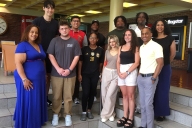You have /5 articles left.
Sign up for a free account or log in.
Last week, leaders from higher education gathered at the White House for a conference on Advancing Interfaith Service on College Campuses. Senior administration officials from the Department of Education, the Corporation for National and Community Service and two White House offices – of Faith-based and Neighborhood Partnerships, and of Social Innovation – addressed the crowd of university presidents, professors, chaplains and students.
That the White House would hold a conference on interfaith cooperation is no mystery; President Obama made the topic a theme of his presidency from the very beginning. But why a gathering that focuses on campuses? I think there are four reasons for this:
- College campuses set the educational and civic agenda for the nation. By gathering higher education leaders, administration officials are signaling that they hope campuses make learning about religious diversity a mark of what it means to be an educated person. And just as campuses helped make volunteerism and multiculturalism a high priority on our nation’s civic agenda, staff in the Obama administration are hopeful that higher education can do the same for interfaith cooperation.
- College campuses are social laboratories that can illustrate what success looks like. While there may be frigid relations between some religious groups in politics and the public square, a college campus has both the mission and the resources (chaplains, diversity offices, religion departments, resident advisers) to proactively cultivate positive relations between Muslims and Jews, Christians and Buddhists, Hindus and Humanists. They can demonstrate cooperation rather than conflict.
- Campuses have the resources and mission to advance a knowledge paradigm – an orientation and body of knowledge that appreciates and possibility engages religious diversity. From Samuel Huntington’s clash of civilizations theory to stories of religious conflict on the evening news to the recent spate of bestsellers by ‘the new atheists,’ we are increasingly subject to a knowledge paradigm about religions being the source for violence, bigotry and ignorance in the world. While this paradigm should certainly be acknowledged, another one can be advanced: that diverse religions share positive values like mercy and compassion that can be acted on across lines of faith for the common good.
- Campuses train the next generation of leaders. Students who have a positive experience of the “religious other” on campus take that worldview into the broader society. Students who develop an appreciative knowledge of the world’s religions on campus educate their neighbors. Students who learn the skills to bring people from different faith backgrounds together to build understanding and cooperation together on the quad apply those skills with their religiously diverse coworkers.
President Obama has shown the way in each of the above categories, and college campuses are uniquely positioned to follow his lead.
In his inaugural address, Obama lifted up America’s religious diversity and connected it to America’s promise: “Our patchwork heritage is a strength not a weakness, we are a nation of Christians and Muslims, Jews and Hindus, and nonbelievers...." The message: Educated citizens should know of our nation’s religious diversity, and it is a civic virtue to engage this diversity positively.
College presidents in America could sound a similar note in speeches to the incoming freshman class.
In the advisory council for the Faith-based Office, the president created his own laboratory that models what positive relations between religiously diverse citizens. I had the honor of serving on the inaugural council (a new group of 25 is expected to be appointed soon). There were Orthodox and Reform Jews, Catholic and Protestant clergy, Sunni and Shia Muslims, Hindu civic leaders and Evangelical movement-builders. And that’s not all -- we were Republicans and Democrats, gay and straight, Mexican and Indian and white and African American. And we had to agree on a final report that went to the president.
College campuses could have an interfaith council that works on common projects.
In Cairo, the president advanced a new “knowledge paradigm” with respect to religious diversity. Eschewing the tired clash of civilizations theory, which falsely claims that religions have opposing values that put them in conflict, Obama highlighted the positive interactions between the West and Islam throughout the course of history, the many contributions Muslim Americans make to their nation, and the dimensions of Islam he admired such as the advancement of learning and innovation.
College campuses can have academic courses that do the same.
As a young adult, Obama was a community organizer working under a Jewish mentor, bringing together Catholic, Protestant and Muslim groups to start job training centers and tutoring programs on the South Side of Chicago. In this way, he acquired the competencies of leadership in a religiously diverse world. The president has signaled that he believes this is a valuable experience for today’s young adults, making interfaith cooperation through service a line in his Cairo address and a theme of the Summer of Service program.
College campuses, with the high value they place on service, leadership development and the positive engagement of diversity, are perfectly prepared to launch robust interfaith service initiatives.
Interfaith initiatives have been growing on campuses for several decades. The White House invited the vanguard of the movement to Washington, D.C., last week with a clear message: this administration appreciates what you have been doing, and we think you can do more. A movement goes from niche to norm when a vanguard recognizes its moment. For the movement of interfaith cooperation, this is the moment.








